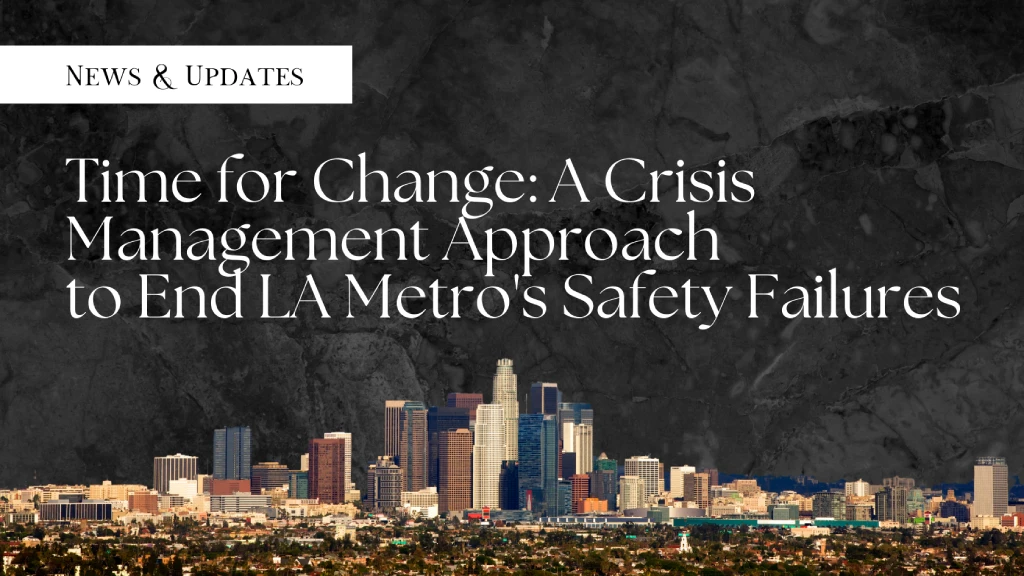The lack of public safety on the LA Metro system has reached a breaking point. The rising wave of violent incidents is no longer just a concern—it is a crisis that demands immediate and decisive action. Just last week, a gunman hijacked a Metro bus, fatally shot a passenger, and led police on an hour-long chase through Los Angeles. In another tragic event last month, a woman was attacked at a Metro rail station in Pasadena and hurled over a concrete barrier into the carpool lane of the 210 freeway. These horrific events are not anomalies; they reflect a more profound, systemic failure within LA Metro’s safety and security framework.
Despite Mayor Karen Bass’s directive in May of this year to increase law enforcement presence by 20% due to a significant uptick in crime, these violent incidents persist. The current strategies are not working, and the lack of public safety expertise in LA Metro’s leadership has led to disorganized and ineffective responses. We face an uncomfortable but urgent question: How many more frontline employees and riders must be victimized before meaningful change happens?
LA Metro can no longer afford to rely on reactive, patchwork solutions. We need a comprehensive, organized approach to a culture of safety to restore order and rebuild public trust in the safety of our transit system. If this were a normal corporate structure, the Board would fire the CEO for her years of rejecting safety programs and projects. Her reliance on the fact that some riders have no choice but to use LA Metro is no justification for disregarding their safety.
The Solution: LA Metro Crisis Management Team (LAM-CMT)
I propose immediately establishing a Crisis Management Team (LAM-CMT) to address the escalating violence and safety concerns. This team would be an ad hoc, high-level task force of top security professionals and law enforcement leaders empowered to make decisive changes and restore safety across the Metro system. Due to the current leadership conditions within LA Metro, this team should report directly to the LA Metro Board, work collaboratively with Metro Security, and be granted temporary authority to execute a “system security turnaround.”
Scope and Responsibilities of the LAM-CMT
The LAM-CMT would tentatively operate for one year or until the LA Metro Board deems the crisis resolved. During this time, the team would focus on:
- Re-establishing order and reducing crime: The team’s priority would be to restore public safety by developing and implementing a comprehensive security plan. That plan would include an assessment of current operations.
- Unified Security Operations: LAM-CMT would consolidate all public safety resources under one unified command, including Transit Security Officers, law enforcement, contract security, transit ambassadors, and homeless outreach services.
- Accountability and Quality Control: The team would ensure that existing public safety contractors are held accountable through performance metrics, and COMPSTAT-based reviews, a proven model for crime reduction and deployment efficiency, and put stringent quality control measures in place to monitor performance.
- Expanding Transit Security Resources: Doubling or tripling the current cadre of Transit Security Officers would be critical to enforcing Metro’s code of conduct and creating a culture of order and safety on the system.
- Leveraging Technology: Integrating advanced security technologies would be a core focus to enhance the system’s overall safety profile to include:
- Facial Recognition and AI: Real-time identification of threats through facial recognition technology and artificial intelligence.
- Enhanced Security Screening: Advanced electronic screening systems at transit hubs to detect weapons and explosives.
- Real-Time Threat Monitoring: Continuous monitoring and threat detection using AI and machine learning.
- “Be On the Lookout” (BOLO) Alerts: Alerts for authorities and security personnel about potential threats.
- Crowd Monitoring and Management: Data analytics and surveillance to monitor crowd movements and detect suspicious behavior.
- Electronic Weapons Detection and Metal Detectors: Systems are deployed to prevent firearms and other weapons from being brought onto public transportation.
- Data-Driven Decision Making: Using analytics to predict potential threats and allow for proactive measures.
Collaborative Leadership
The LAM-CMT should have a designated and respected leader, supported by team leaders with specialized responsibilities: COMPSTAT, Security Deployment, Technology, and Public Safety. These leaders would have full authority to make operational decisions during this crisis period and would be tasked with ensuring a coordinated response across LA Metro’s security ecosystem. This collaboration will extend to partner city law enforcement agencies, ensuring Metro’s public safety efforts align with LAPD, Long Beach PD, and the Los Angeles County Sheriff’s Department at the highest levels.
Why Now?
The LA Metro Board has already approved the creation of its own police department, but the timeline for implementation stretches over five years—well past the 2028 Olympics. We cannot afford to wait. The surge in crime requires immediate, sustained action. Implementing a unified public safety department under LA Metro’s control within three years is critical to ensuring a secure and welcoming environment for riders, especially as we prepare for the influx of visitors during the 2028 Olympics.
It’s not enough for board members to express outrage after every tragic event. Isolated solutions won’t fix this. We need a well-resourced, strategic plan that prioritizes the safety of Metro riders and employees. The LAM-CMT would provide the clear leadership and coordinated action that LA Metro desperately needs.
Collaborative Leadership
The violent incidents plaguing LA Metro are not just disturbing—they are a clear signal that current public safety culture is failing. Politically motivated, reactive, piecemeal solutions are words over substance. A comprehensive crisis management approach is the only way to restore order, rebuild trust, and create a safe, clean, reliable public transportation system. The LAM-CMT offers a practical, immediate solution to address the crisis head-on, with the urgency it demands. Replacement of the current CEO is part of change needed. If she is allowed any authority over the LAM-CMT – the effort will be doomed before it starts. All of her recent “upgrades” are proposals made to her previous and which she rejected as too costly. She needs to stop restricting safety proposals for which she has no experience, training, or expertise. The cost in lives lost has proven her wrong.
LA Metro’s employees and riders deserve better. We need a plan—and we need it now.

